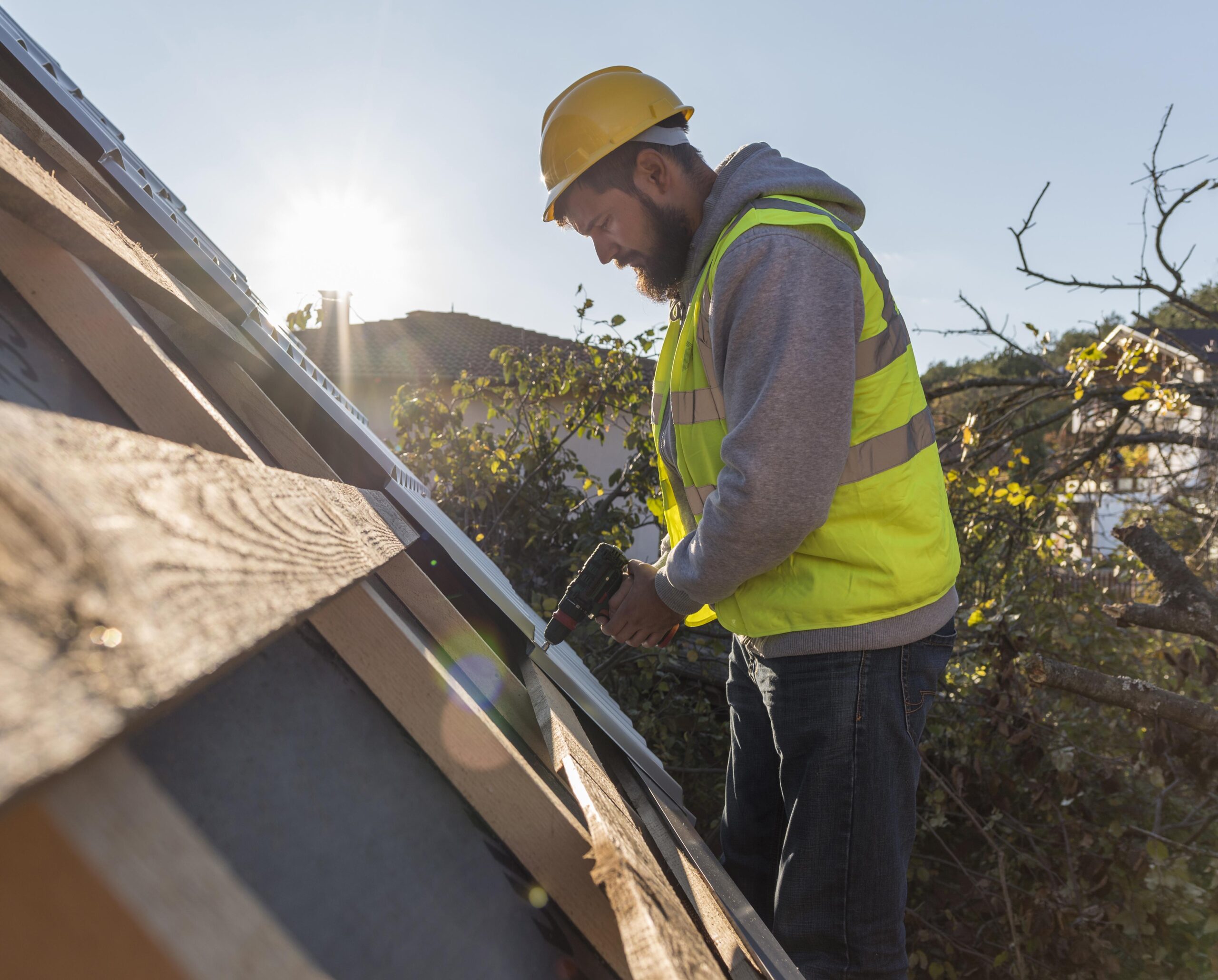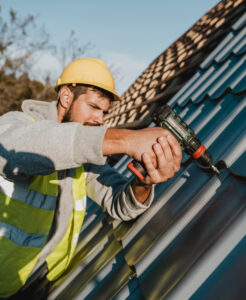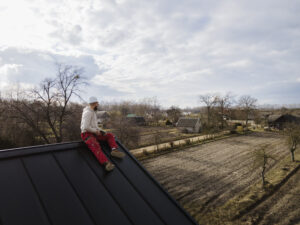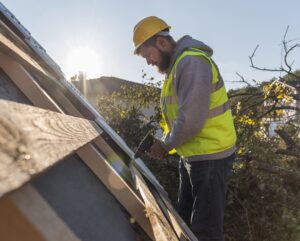Tampa Roofing Repair: Your Complete Guide to Fixing Roof Problems

Quick Summary / Key Takeaways
If you only remember 5 things from this guide, make it these:
- Regular roof inspections can identify minor issues before they become major, costly repairs.
- Common Tampa roofing problems include leaks, shingle damage, and storm-related damage from hurricanes.
- Choosing a reputable Tampa roofing contractor is crucial for quality repairs and lasting results.
- Proper roof maintenance, such as cleaning and debris removal, extends your roof’s lifespan significantly.
- Understanding Tampa’s building codes and permit requirements is essential before starting any roofing repair project.
Common Roofing Problems & Solutions
| Problem | Description | Typical Solution | Estimated Cost |
| Leaking Roof | Water intrusion causing interior damage. | Patching, shingle replacement, or full replacement. | $300 – $10,000+ |
| Missing Shingles | Shingles blown off by wind or deteriorated. | Shingle replacement. | $150 – $500 |
| Sagging Roof | Indicates structural damage or water accumulation. | Structural repair or roof replacement. | $1,000 – $20,000+ |
| Granule Loss | Shingle granules wearing away, reducing UV protection. | Roof coating or replacement. | $500 – $10,000+ |
Roofing Material Comparison
| Material | Lifespan | Cost (per sq ft) | Pros |
| Asphalt Shingles | 15-30 years | $3 – $5 | Affordable, versatile, easy to install. |
| Tile Roofing | 50-100 years | $10 – $20 | Durable, fire-resistant, aesthetically pleasing. |
| Metal Roofing | 40-70 years | $8 – $15 | Long-lasting, energy-efficient, weather-resistant. |
| Wood Shingles | 20-40 years | $7 – $12 | Natural look, good insulation, eco-friendly. |
Launch Checklist
- Schedule a professional roof inspection.
- Obtain multiple quotes from licensed Tampa roofing contractors.
- Verify the contractor’s insurance and licensing.
- Review the contractor’s portfolio and references.
- Secure all necessary permits before starting work.
- Establish a clear payment schedule with the contractor.
Follow-Up Checklist
- Inspect the completed roof repair work thoroughly.
- Ensure all debris is removed from the property.
- Obtain all warranty documentation from the contractor.
- Schedule regular roof maintenance checks.
- Keep records of all roofing repairs and maintenance.
- Consider a roof coating for extended protection.
Introduction
Tampa’s climate can be tough on roofs. The intense sun, heavy rains, and occasional hurricanes all contribute to wear and tear. Recognizing the signs of roof damage early can save you thousands of dollars in costly repairs. This guide will walk you through common roofing problems in Tampa, how to address them, and how to prevent future issues. Learn about reliable roofing solutions to keep your home safe and dry. Click here to get started.
Table of Contents
Section 1: Identifying Common Tampa Roofing Problems
- What are the most frequent causes of roof leaks in Tampa?
- How can I identify missing or damaged shingles?
- What does a sagging roof indicate, and how serious is it?
- How does granule loss affect my roof’s performance?
- What are the signs of storm damage on a roof?
- Can moss or algae growth damage my roof?
- What is the role of proper attic ventilation in roof health?
Section 2: Choosing the Right Tampa Roofing Contractor
- How do I find a reputable and licensed roofing contractor in Tampa?
- What questions should I ask potential roofing contractors?
- How important is it to check a contractor’s insurance and licensing?
- What are red flags to watch out for when hiring a roofer?
- Should I get multiple quotes before choosing a contractor?
- How can I verify a contractor’s references and past work?
- What should be included in a roofing repair contract?
Section 3: Roof Repair and Maintenance Best Practices
- How often should I have my roof inspected in Tampa?
- What are some simple roof maintenance tasks I can do myself?
- How do I clean my roof safely and effectively?
- What types of roof coatings are available, and are they worth it?
- How can I prevent ice dams and water damage during the rainy season?
- What is the best way to remove debris from my roof?
- When is it time to consider a full roof replacement instead of repair?
Frequently Asked Questions
Section 1: Identifying Common Tampa Roofing Problems
FAQ 1: What are the most frequent causes of roof leaks in Tampa?
Roof leaks in Tampa are often caused by damaged or missing shingles, deteriorated flashing around chimneys and vents, and storm damage. The intense heat and humidity can also degrade roofing materials over time, leading to cracks and leaks. Regular inspections and prompt repairs are crucial to prevent water damage. Addressing issues quickly can save significant money. Tampa Roofing Experts can help with inspections.
Real Results: One Tampa homeowner saved $3,000 by catching a small leak early, preventing major structural damage.
Takeaway:
Inspect your roof regularly for signs of damage to prevent costly leaks.
FAQ 2: How can I identify missing or damaged shingles?
Missing or damaged shingles can be identified by visually inspecting the roof for bare spots, curled edges, or cracked shingles. You may also find shingle granules in your gutters, indicating wear and tear. If you notice any of these signs, it’s important to address the issue promptly. Neglecting shingle damage can lead to leaks and further damage. Replacing missing shingles is often a simple repair.
Real Results: A homeowner noticed missing shingles after a storm and prevented a leak by replacing them immediately.
Takeaway:
Check your roof after storms for missing or damaged shingles.
FAQ 3: What does a sagging roof indicate, and how serious is it?
A sagging roof typically indicates structural damage, often caused by water accumulation or rot in the underlying support beams. This is a serious issue that requires immediate attention from a qualified roofing contractor. Ignoring a sagging roof can lead to a collapse, posing a significant safety hazard. Addressing the problem quickly is essential to prevent further damage and ensure the safety of your home.
Real Results: A Tampa family discovered a sagging roof just in time, preventing a complete roof collapse.
Takeaway:
Address a sagging roof immediately to prevent structural damage and potential collapse.
FAQ 4: How does granule loss affect my roof’s performance?
Granule loss reduces a shingle’s ability to reflect sunlight and protect the underlying asphalt from UV damage, shortening the roof’s lifespan. As granules wear away, the shingles become more vulnerable to cracking and leaking. Regular inspections can help identify excessive granule loss early on. Consider a roof coating to extend the life of shingles. Proper maintenance can slow this process.
Real Results: A Tampa homeowner extended their roof’s life by 5 years by applying a roof coating after noticing granule loss.
Takeaway:
Monitor your roof for granule loss to prevent premature aging.
FAQ 5: What are the signs of storm damage on a roof?
Signs of storm damage include missing shingles, dents from hail, tree branch impacts, and water stains on ceilings. After a storm, carefully inspect your roof for any visible damage. Even minor damage can lead to leaks and further problems down the road. Promptly addressing storm damage is crucial for protecting your home. Roof repair costs depend on the extent of damage.
Real Results: A Tampa homeowner filed an insurance claim for storm damage, covering the cost of shingle replacement.
Takeaway:
Inspect your roof after storms for signs of damage, and file an insurance claim if necessary.
FAQ 6: Can moss or algae growth damage my roof?
Yes, moss and algae growth can trap moisture on the roof surface, leading to shingle deterioration and rot. They also create an unsightly appearance and can reduce the roof’s energy efficiency. Regular cleaning and treatment can prevent moss and algae from damaging your roof. Removing debris prevents moisture retention. This improves the longevity of roofing.
Real Results: A Tampa resident saved on energy bills by removing moss from their roof, improving its reflectivity.
Takeaway:
Remove moss and algae growth to prevent roof deterioration and improve energy efficiency.
FAQ 7: What is the role of proper attic ventilation in roof health?
Proper attic ventilation helps regulate temperature and humidity, preventing moisture buildup that can damage roofing materials. Adequate ventilation also reduces the risk of ice dams in winter and keeps the attic cooler in summer. This extends the life of the roof and reduces energy costs. Good ventilation prevents mold growth. Proper insulation is also key.
Real Results: A Tampa homeowner reduced their energy bills by improving attic ventilation, preventing heat buildup.
Takeaway:
Ensure proper attic ventilation to regulate temperature and humidity, extending your roof’s lifespan.
Section 2: Choosing the Right Tampa Roofing Contractor
FAQ 8: How do I find a reputable and licensed roofing contractor in Tampa?
Finding a reputable Tampa roofing contractor involves checking online reviews, verifying licensing with the Florida Department of Business and Professional Regulation, and asking for referrals from friends or neighbors. A licensed contractor has met certain qualifications and is insured, protecting you from liability. Always verify credentials before hiring. Read reviews from past clients.
Real Results: A Tampa homeowner found a reliable contractor through a referral, ensuring quality workmanship.
Takeaway:
Verify a contractor’s license and check online reviews before hiring.
FAQ 9: What questions should I ask potential roofing contractors?
Ask potential roofing contractors about their experience, insurance coverage, warranty policies, and the materials they use. It’s also important to inquire about their project timeline and payment schedule. A good contractor will be transparent and willing to answer all your questions. Request references from past clients. Get everything in writing.
Real Results: A Tampa homeowner asked detailed questions and chose a contractor with a comprehensive warranty.
Takeaway:
Ask detailed questions about experience, insurance, warranties, and materials before hiring.
FAQ 10: How important is it to check a contractor’s insurance and licensing?
Checking a contractor’s insurance and licensing is crucial to protect yourself from liability in case of accidents or damages during the roofing project. Insurance covers any injuries or property damage, while licensing ensures the contractor meets industry standards. Hiring an unlicensed or uninsured contractor can be risky. Verify coverage details.
Real Results: A Tampa homeowner avoided liability by hiring an insured contractor after an accident occurred on their property.
Takeaway:
Verify a contractor’s insurance and licensing to protect yourself from liability.
FAQ 11: What are red flags to watch out for when hiring a roofer?
Red flags include a contractor who demands full payment upfront, lacks proper licensing or insurance, provides vague estimates, or pressures you into signing a contract immediately. Be wary of contractors who offer unrealistically low prices or avoid answering your questions directly. Trust your instincts and choose a contractor you feel comfortable with. Obtain multiple quotes.
Real Results: A Tampa homeowner avoided a scam by recognizing red flags and choosing a different contractor.
Takeaway:
Be wary of contractors who demand full payment upfront or lack proper credentials.
FAQ 12: Should I get multiple quotes before choosing a contractor?
Yes, it’s highly recommended to get multiple quotes from different roofing contractors before making a decision. This allows you to compare prices, services, and warranties. Getting at least three quotes is a good practice. Comparing quotes helps you make an informed decision and find the best value for your money. Review estimate details.
Real Results: A Tampa homeowner saved $1,000 by comparing quotes from multiple roofing contractors.
Takeaway:
Obtain multiple quotes to compare prices, services, and warranties.
FAQ 13: How can I verify a contractor’s references and past work?
Verify a contractor’s references by contacting their previous clients and asking about their experience with the contractor’s work quality, timeliness, and professionalism. You can also ask to see examples of their past projects. Seeing the work firsthand can give you confidence. Check online reviews, too.
Real Results:
A Tampa homeowner contacted references and confirmed the contractor’s excellent reputation.
Takeaway: Contact references to verify a contractor’s work quality and professionalism.
FAQ 14: What should be included in a roofing repair contract?
A roofing repair contract should include a detailed description of the work to be performed, the materials to be used, the total cost, the payment schedule, the project timeline, and the warranty information. It should also specify who is responsible for obtaining permits and handling any unexpected issues. A clear contract protects both parties. Read the fine print.
Real Results: A Tampa homeowner had a clear contract, preventing disputes and ensuring a smooth repair process.
Takeaway:
Ensure your roofing contract includes all essential details to protect both parties.
Section 3: Roof Repair and Maintenance Best Practices
FAQ 15: How often should I have my roof inspected in Tampa?
In Tampa, it’s recommended to have your roof inspected at least once a year, and after any major storms. Regular inspections can identify minor issues before they become major problems. Early detection saves you money and extends the life of your roof. Schedule inspections with a qualified professional. Preventative maintenance is vital.
Real Results: A Tampa homeowner prevented a major leak by scheduling regular roof inspections.
Takeaway:
Schedule annual roof inspections and after major storms to identify potential problems early.
FAQ 16: What are some simple roof maintenance tasks I can do myself?
Simple roof maintenance tasks include removing debris from gutters and the roof surface, trimming overhanging tree branches, and checking for any visible signs of damage. Be cautious when working on the roof, and consider hiring a professional for tasks that require climbing or specialized equipment. Safety is most important. Regular upkeep extends life.
Real Results: A Tampa homeowner prevented water damage by regularly cleaning their gutters.
Takeaway:
Remove debris from gutters and trim overhanging branches to maintain your roof.
FAQ 17: How do I clean my roof safely and effectively?
Clean your roof safely by using a soft brush or broom to remove debris, and a garden hose with a low-pressure nozzle to rinse away dirt and algae. Avoid using high-pressure washers, as they can damage shingles. Consider using a roof cleaning solution specifically designed for your roofing material. Always wear safety gear. Prevent falls.
Real Results: A Tampa homeowner cleaned their roof safely, removing algae and improving its appearance.
Takeaway:
Clean your roof safely with a soft brush and low-pressure water to remove debris and algae.
FAQ 18: What types of roof coatings are available, and are they worth it?
Various roof coatings are available, including acrylic, silicone, and elastomeric coatings. These coatings can extend the life of your roof, improve energy efficiency, and prevent leaks. The worth of a roof coating depends on the condition of your roof and your budget. Consider the long-term benefits. Select a coating appropriate for materials.
Real Results: A Tampa homeowner reduced energy costs by applying a reflective roof coating.
Takeaway:
Consider a roof coating to extend the life of your roof and improve energy efficiency.
FAQ 19: How can I prevent ice dams and water damage during the rainy season?
While ice dams are rare in Tampa, preventing water damage during the rainy season involves ensuring proper attic ventilation, sealing any leaks around pipes and vents, and keeping gutters clean. These measures help prevent water from backing up and causing damage to your roof and interior. Monitor attic humidity. Ensure proper sealing.
Real Results: A Tampa homeowner prevented water damage by ensuring proper attic ventilation.
Takeaway:
Ensure proper attic ventilation and clean gutters to prevent water damage during the rainy season.
FAQ 20: What is the best way to remove debris from my roof?
The best way to remove debris is using a soft brush, leaf blower, or garden hose with a low-pressure nozzle. Avoid using metal tools or high-pressure washers, as they can damage the roofing material. Be cautious when working on the roof, and consider hiring a professional if you’re uncomfortable. Safety is the priority. Prevent falls.
Real Results: A Tampa homeowner safely removed debris from their roof using a soft brush and garden hose.
Takeaway:
Remove debris with a soft brush or leaf blower to avoid damaging the roofing material.
FAQ 21: When is it time to consider a full roof replacement instead of repair?
Consider a full roof replacement when your roof is nearing the end of its lifespan, has extensive damage, or requires frequent repairs. If repairs are becoming more costly than a replacement, it’s likely time for a new roof. A new roof can also increase your home’s value. Weigh the costs and benefits. Schedule inspections.
Real Results: A Tampa homeowner opted for a full roof replacement after frequent repairs became too costly.
Takeaway:
Consider a full roof replacement if your roof is old, extensively damaged, or requires frequent repairs.
Recent Post

Roof Replacement Tampa: Your Complete Guide to a Secure Home

St. Petersburg, FL Roofing: Your Expert Guide





